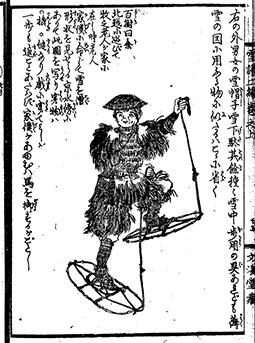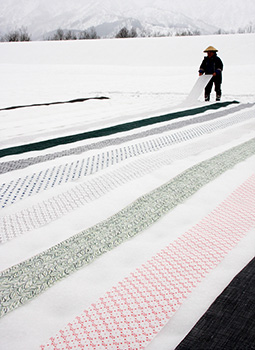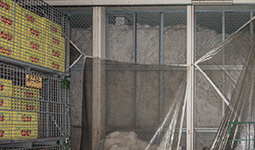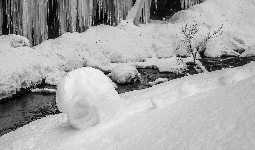INDEX
- English
- 日本語

Onodera Satoshi, a researcher at the Nishiwaga Town Snow Country Cultural Institute in Iwate Prefecture, holds a kanjiki snow shoe - English
- 日本語

Kansetsu, an umbrella-like cap of snow that forms atop bushes or rocks

Nozawana pickles 
Large kanjiki known as sukari depicted in the book Hokuetsu Seppu 
Yukisarashi, the practice of bleaching woven cloth on a snowfield, in Ojiya City, Niigata Prefecture 
A farm produce storage facility using snow in Nishiwaga Town 
Yukimakuri, a naturally formed wheel of snow 
Kera, garments worn to keep the body dry in the rain or snow, embroidered around the neck, on display at the Hekisyouji Museum in Nishiwaga Town
January 2022
The Bounties of Snow

The heavy snowfall areas in Japan account for around half the country’s land area. We spoke to Onodera Satoshi, a researcher at the Nishiwaga Town Snow Country Cultural Institute in Iwate Prefecture, about the various technologies and culture that have been fostered in the heavy snowfall areas in Japan.
Many parts of Japan get snow in winter, but which areas have particularly heavy snowfall?
Hokkaido (the northernmost of Japan’s four main islands), mountainous areas of Honshu (the largest main island), and the Sea of Japan coast in particular receive large amounts of snow. In winter, cold seasonal winds blowing from Siberia bring clouds to Japan containing large amounts of moisture picked up from the warm Tsushima Current in the Sea of Japan. The clouds develop over Hokkaido and Honshu and cause large amounts of snow to fall.
These weather conditions result in much higher snowfall in Japan than in other countries located at the same latitude. For example, Niigata Prefecture and Nagano Prefecture, which are two of the heaviest snowfall areas in Honshu, are located at a similar latitude to warm areas in Europe such as Athens in Greece and Lisbon in Portugal, and places such as San Francisco in North America.
Areas with heavy snowfall are designated by the government as “heavy-snowfall areas” based on the Act on Special Measures concerning Countermeasures for Heavy-snowfall Areas enacted in 1962. The government implements measures to improve living standards, promote industry, and prevent disasters in the heavy-snowfall areas. As of April 2021, Heavy Snowfall Areas account for 51 percent* of Japan’s land area, inhabited by around 15 percent of the country’s population (approximately 19 million people).
Nishiwaga Town, Iwate Prefecture, where I live, is in a mountainous part of Japan’s Tohoku region in northern Honshu and designated as one of the “special heavy-snowfall areas” which receive larger amounts of snow among heavy-snowfall areas. Here, snow doesn’t melt from mid-December through mid-April, accumulating to a depth of around two meters from early February through early March.
What methods did people devise to get through the bitterly cold and very snowy winters before scientific and technological developments?
In heavy snowfall areas where it’s difficult to get fresh vegetables in winter, vegetables and other foods are preserved, in a variety of ways. Tsukemono pickles are an example. The wild vegetables that grow in the mountains or vegetables harvested in the fields were not only eaten in season but also preserved for consumption in winter using salt and miso. Here in Nishiwaga Town, whole daikon radish preserved by pickling with salt in wooden barrels, a tsukemono called ippon-zuke, has been made since long ago. Similarly, a tsukemono specialty of Niigata and Nagano Prefectures is a vegetable called nozawana pickled in salt.

Various implements have also been developed by people living in heavy snowfall areas. One such implement is kanjiki, used for walking on the snow without the feet sinking down. Kanjiki are made by bending long, thin pieces of wood using heat from hot water or ashes from an open hearth to create the outer frame. They may be circular or oval in shape, depending on the region where they’re made. Wearing kanjiki under shoes increases the area of the foot in contact with the snow, distributing the weight of the wearer evenly, preventing them sinking into the snow too deeply and making it easier to walk.

Similar footwear has been made by people who live in heavy snowfall areas overseas, such as the indigenous people of North America, and people in different parts of Japan have made various kinds of kanjiki. Suzuki Bokushi (1770–1842), a merchant from Echigo (present-day Niigata Prefecture), described large kanjiki called sukari in his Hokuetsu Seppu, wide-ranging writings on the nature, customs, and industries of the heavy snowfall region of Echigo. Hokuetsu Seppu was published in 1837 and became a best-seller of its time for its detailed descriptions of the realities of heavy snowfall areas that were largely unknown to people in cities such as Edo (present-day Tokyo).
These days, kanjiki are not commonly used, but the Snow Country Culture Institute offers a program for visitors to experience walking on snow wearing kanjiki. Participants are impressed by the feel of the snow and the pure white snowy landscape of a snowfield on which they would not normally be able to walk.
What cultural practices have been fostered in heavy snowfall areas?
One example is textiles. Until the spread of mechanical looms in the Meiji period (1868–1912), cloth was woven mainly by women in agricultural communities during the off-season in winter, and became a valuable source of cash income for farmers. Particularly famous textiles from areas with heavy snowfall are Ojiya-chijimi and Echigo-jofu in Niigata Prefecture, both of which are inscribed on UNESCO’s Representative List of the Intangible Cultural Heritage of Humanity. The textiles are woven using yarn spun from karamushi, a type of hemp, and the process of making them is described in detail in Hokuetsu Seppu, including yukisarashi, the practice of spreading the woven cloth out on the snowfield and exposing it to the sun to bleach it.

Another cultural practice fostered in rural communities in areas with heavy snowfall is yui, a culture of mutual support whereby residents work together to plant and harvest rice, build and repair houses, and clear snow in winter. Living in such a harsh natural environment, helping one another was essential for residents to survive.
In recent years, with the population in rural areas aging, the number of people who are able to clear snow from their houses has been declining, which has become a serious problem. In response to this situation, in 1993 a volunteer group called Snow Busters was formed mainly by younger residents of Nishiwaga Town to clear snow from the homes of the elderly. Later, this kind of group activity spread to other areas. I believe this is an example of the tradition of yui in areas of heavy snowfall being passed down through the generations.
How is snow being used in Japan?
Come spring, the snow turns into large volumes of meltwater, which benefits people greatly. In many areas where there is heavy snowfall, rice cultivation flourishes thanks to the abundant snowmelt. Meltwater is also essential for industrial water and hydroelectric power generation.
More recently, snow has come to be used as an environmentally friendly energy resource. Nishiwaga Town pioneered this initiative in Japan. In 1989, the first agricultural storage facility equipped with a snow storage room was built. In 2000, the facility was extended, increasing the snow storage capacity to 250 tons. The snow in the room cools the air, which in turn cools the farm produce in the agricultural storage rooms. In 1994, a separate facility with a snow storage capacity of 150 tons was built. Produce such as cut lilies, apples, strawberries, and buckwheat seeds are refrigerated in these storage facilities. The temperature inside the facilities is kept at between 0 and 4 degrees Celsius year round and the humidity at between 85 and 99 percent, enabling agricultural produce to be preserved for long periods.

Since the 1990s, efforts to use snow to cool buildings and store farm produce have spread to the prefectures of Hokkaido, Yamagata, Niigata, and other areas with heavy snowfall. In the past, most of the snow removed from roads and buildings was simply dumped into rivers and drainage channels, or piled up on open ground. I believe that using snow as a resource will become even more important in the future in order to save fossil fuels and reduce carbon emissions.
What experiences would you like overseas visitors to Japan to enjoy during the snow season once the COVID-19 pandemic subsides?
I’d like them to see and touch the snow for themselves. Many places offer programs such as walking on snow using kanjiki and making kanjiki, and visitors to the Tsugaru region of Aomori Prefecture can take part in a tour to experience the jifubuki phenomenon of upward drifting snow. (See Highlighting Japan, February 2018, “Adventures on Fields of Drifting Snow.”)
I’d also like them to check out snow formations. Takahashi Kihei (1910–2006), the first director of the Snow Country Cultural Institute, noticed the beauty of the different shapes created by snow and took many photographs of them. For example, kansetsu are snow formations in the shape of the umbrella-like cap of a mushroom on top of bushes and rocks, while yukimakuri are chunks of snow that have rolled down a slope and formed a wheel-like shape. If visitors look at the snowy landscape with a little attention, they will be able to spot these beautiful natural 3D artworks.


I hope visitors will also see the cultural assets unique to areas of heavy snowfall. On display at the Hekisyouji Museum in Nishiwaga Town are more than 10,000 items including clothing, footwear, sleds, farming equipment, and hunting tools, some of which are designated as Important Tangible Folk Cultural Properties, allowing visitors to learn about the lives of people in heavy snowfall areas. The museum displays a large number of kera, sleeveless raincoats made of plant leaves worn to help keep dry in the rain or snow. Among them are special kera made as wedding gifts by mothers for their daughters. The beautiful embroidery around the necks of the special kera gives a feel for the mothers’ love and desire for their daughters’ happiness.

I’d like many people to know about the natural environment of these heavy snowfall areas, and the traditions and cultural practices that are passed down through the generations.
* See Ministry of Land, Infrastructure, Transport and Tourism website: https://www.mlit.go.jp/common/001325166.pdf

